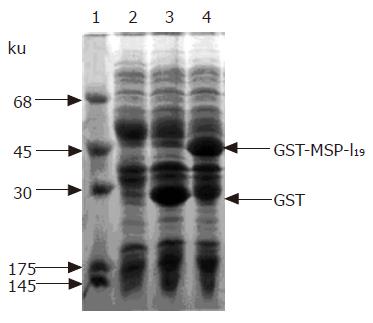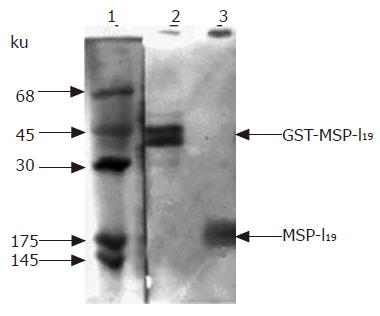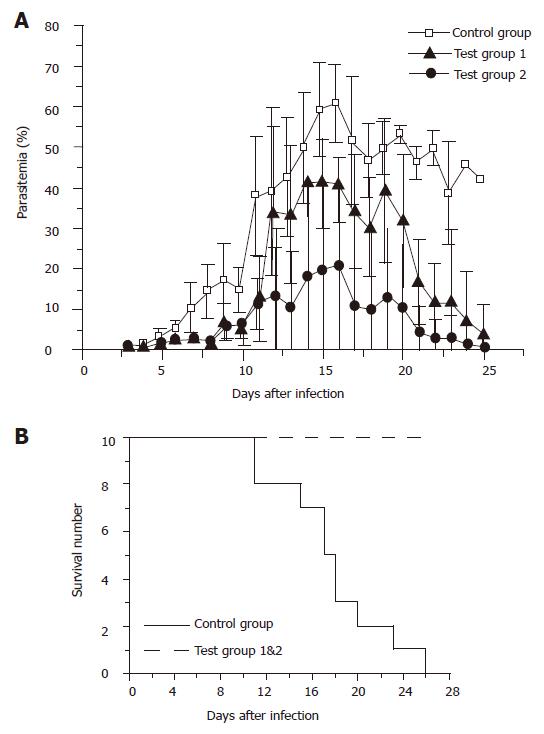Copyright
©2005 Baishideng Publishing Group Inc.
World J Gastroenterol. Nov 28, 2005; 11(44): 6975-6980
Published online Nov 28, 2005. doi: 10.3748/wjg.v11.i44.6975
Published online Nov 28, 2005. doi: 10.3748/wjg.v11.i44.6975
Figure 1 Expression of fusion protein in E.
coli BL21 cells. Coomassie brilliant blue-stained 12% SDS-polyacrylamide gel. lane 1, protein markers; lane 2, total protein of BL21 cells; lane 3, total protein of E. coli BL21 transformed with plasmid pGEX-5X-3 with IPTG induction; lane 4, total protein of E. coli BL21 cells harboring plasmid pGEX-MSP-119 after with IPTG induction. The arrows indicate the positions of GST and fusion protein GST-MSP-119.
Figure 2 Immunoblotting analysis of MSP-119 expressed in L.
lactis. Protein samples were first analyzed on 12% SDS-polyacrylamide gel and then transferred on nitrocellulose membrane followed by immunostaining with antiserum prepared by infecting mouse with P. yoelii parasites. lane 1, protein markers stained by amido black; lane 2, positive control of fusion protein GST-MSP-119 purified from E. coli cell lysate expressing the fusion protein by pGEX-MSP-119; lane 3, total protein of L. lactis cells harboring plasmid pL2-PSGT. The arrows indicate the position of fusion protein GST-MSP-119 and MSP-119.
Figure 3 Blood-stage parasitemia of immunized BALB/c mice challenged with P.
yoelii 265BY parasites. Mice were orally administered with PBS in the control group 1 (-□-), with 5×109 per dose of free L. lactis cells in the control group 2
Figure 4 (A) Blood-stage parasitemia of immunized C57BL/6 mice challenged with P.
yoelii 265BY parasites. Mice were orally administered with 5×109 per dose of free L. lactis cells in the control group (-□-), with 5×109 pL2-PSGT plasmid-harbored L. lactis cells per dose in the test group 1 (-▲-), and with 1×108 cells per dose of pL2-PSGT plasmid-harbored L. lactis cells in the test group 2 (-●-). Immunization procedure is described in Materials and Methods, and each mouse was challenged with 1×105 asexual blood-stage P. yoelii parasites. (B) Time course of survivals of the mice in the three groups is indicated in A.
-
Citation: Zhang ZH, Jiang PH, Li NJ, Shi M, Huang W. Oral vaccination of mice against rodent malaria with recombinant
Lactococcus lactis expressing MSP-119. World J Gastroenterol 2005; 11(44): 6975-6980 - URL: https://www.wjgnet.com/1007-9327/full/v11/i44/6975.htm
- DOI: https://dx.doi.org/10.3748/wjg.v11.i44.6975












